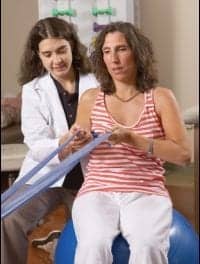
A stander can allow a child to interact with family and peers at eye level, in the home or community. (Image courtesy of EasyStand.)
by Stephanie Yu Covert, PT, MSPT
The International Classification of Functioning, Disability and Health (ICF) model describes disabilities at multiple levels: health condition, body structure and function, activity, and participation. Personal and contextual factors also contribute to a child’s overall well-being and function. ICF defines participation as, “involvement of people in all areas of life, and the participation restrictions they experience (functioning of a person as a member of society.)”1
In the pediatric community, there is a strong push to provide meaningful interventions which maximize a child’s abilities at the participation level of the ICF model. Historically, physical therapy has focused on therapeutic interventions at a body structure and activity level. Currently, the focus has shifted toward participation-level interventions. Participation has two key components: attendance and involvement.2 In other words, a child needs to be able to attend an event and be actively involved in their community. The ultimate goal is to help children fulfill life roles in their natural environments, versus performing structured tasks in a clinic setting. Similarly, the use of durable medical equipment (DME) has expanded from addressing body structure and activity-level issues to encouraging participation. In the sea of pediatric DME that is available, one may need guidance about what equipment to choose and when to recommend it. This article aims to: 1) provide an overview of pediatric standers, gait trainers, and strollers, and 2) discuss considerations for this DME based on a child’s age and diagnosis.
Standers
There are simple to complex standers available for the pediatric population: tilt tables, standing frames, supine standers, prone standers, and sit-to-stand standers. Some offer both full supine positioning and partial prone. Standers may be stationary or mobile with larger wheels that allow a child to self-propel in a standing position. Special accessories include a hip and knee contracture system to accommodate joint contractures, as well as adjustable features to allow a child to stand with a selected amount of hip abduction.
Children with cerebral palsy (CP) can be classified using the Gross Motor Functional Classification System (GMFCS). Five distinct levels describe a child’s functional abilities, with Level I being the highest functioning (ambulatory without an assistive device) and Level V being the lowest (non-ambulatory).3 As the GMFCS level becomes higher, so does the risk for hip dislocation.4 As such, standers play an important role in a comprehensive hip surveillance program. To prevent hip dislocation, children at GMFCS Level III, IV, and V should be assessed early for a stander, preferably as young toddlers. DME manufacturers have recognized this important demand by offering smaller-sized standers for the early intervention population.
Another population who may benefit from standers is children with Duchenne muscular dystrophy (DMD). As these children enter the early non-ambulatory phase, usually in late childhood or adolescence, they should be assessed for a stander to maintain lower extremity range of motion (ROM)5 and delay the onset of scoliosis. Standers may further assist with bowel function and respiration.
While early standing is encouraged for children with CP, it is not always maintained as a child gets older and becomes larger to handle. Some older children may be overlooked for standing programs because they have already developed lower extremity contractures. However, it is important to investigate the possibility of resuming a standing program for this population. Medical clearance is recommended for children who have not stood over time, as osteopenia and fracture risk may be present. A recent case report showed how an adolescent at GMFCS Level V, with 40-degree hip and knee flexion contractures, successfully resumed a standing program that improved lower extremity ROM and bowel function, as well as decreased pain.6 From a participation perspective, the family reported that the patient expressed happiness and watched television with his brother while in the stander.
While a stander addresses important body structure issues such as hip integrity, lower extremity ROM, and preventing spine deformities, it may also promote participation by allowing a child to interact and play with family and peers at eye level, in the home or community. A stander may increase a child’s arousal state, thereby improving attention span and participation as a student at school. Mobile standers may promote participation in the home by helping children gain independence in activities of daily living (ADLs) that require standing, such as meal preparation at a kitchen counter.
Gait Trainers
Various options exist for pediatric gait trainers. The frame may be open in the front or back. An open front end may afford a child better access to objects and promote socialization without a physical barrier between the user and other children. Pelvic supports may be static or dynamic. Dynamic systems may facilitate weight shifting and weight bearing during gait. Traditional gait trainers have small wheels, such that the child is expected to propel the device exclusively with his or her feet. However, the market now offers gait trainers with additional large wheels that a child can push with his or her hands, to assist the legs with forward propulsion. This type of gait trainer may be helpful for children who have difficulty reciprocating their legs, weakness, or low endurance. There are many accessories available to provide support and meet a child’s specific needs. Examples include straps to keep hips abducted, friction wheels to control the speed of walking, locking or swivel caster wheels, and forearm prompts for children who have difficulty grasping.
Children with CP have less physical activity (PA) than peers who are typically developing.7 As such, they need opportunities for PA. Gait trainers may help fill this need, especially for children at GMFCS Level IV and possibly for those at Level V. Gait trainers may promote participation by giving a child a means of self-initiated mobility in the community. Therapists should be mindful that some gait trainers are easier than others to disassemble and transport in a car.
Strollers
Pediatric strollers can be simple with sling-type seating, or complex with a full seating system. Accessories are available to meet a child’s positioning needs such as head supports, trunk supports, and chest harnesses. As such, they may be an option for children at GMCFS Level II to V. They should also be considered for children with DMD in the early to late ambulatory stage with the purpose of energy conservation in the community.
Adapted strollers may promote participation in the community because they may be easier for a family to transport than a traditional wheelchair. Families may also be more encouraged to take their child with special needs into the community in a stroller because it looks more typical and less stigmatizing than a wheelchair. Yet, as the child grows larger, the weight and size of a stroller may begin to compare to a manual wheelchair. At this point a wheelchair may be easier to fold and disassemble for transport in an automobile.
Conclusion
Therapists play an important role in promoting participation among children with special needs. Selecting DME that only addresses body structure impairments is insufficient. Children need DME that helps them access their community and fulfill life roles such as sons or daughters, brothers or sisters, students, friends, and active members of society. Pediatric standers, gait trainers, and strollers may help meet those needs. RM
Stephanie Yu Covert, PT, MSPT, PCS, is a Physical Therapy Manager at Los Angeles County, California Children’s Services with more than 20 years of pediatric experience. She earned a Master of Science in Physical Therapy from Boston University and a Bachelor of Science in Kinesiology from UCLA. She has been Board Certified in Pediatric Physical Therapy since 2002. In 2016, she was Associate Editor for the journal Pediatric Physical Therapy. She served 4 years on the American Board of Physical Therapy Specialties and was Chair from 2013 to 2014. She received the 2013 APTA Section on Pediatrics, Outstanding Pediatric Clinician Award. For more information, contact [email protected].
References
1. World Health Organisation. International classification of functioning, disability, and health: children & youth version: ICF-CY. Geneva: World Health Organization, 2007.
2. Imms C, Granlund M, Wilson PH, Steenbergen B, Rosenbaum PL, Gordon AM. Participation, both a means and an end: a conceptual analysis of processes and outcomes in childhood disability. Dev Med Child Neurol. 2017;59:16-25. doi: https://www.doi.org/10.1111/dmcn.13237
3. Rosenbaum PL, Palisano RJ, Bartlett DJ, et al. Development of the Gross Motor Function Classification System for cerebral palsy. Dev Med Child Neurol. 2008;50(4):249-253.
4. Soo B, Howard JJ, Boyd RN, et al. Hip displacement in cerebral palsy. J Bone Joint Surg Am. 2006 Jan;88(1):121-9.
5. Birnkrant DJ, Bushby K, Bann CM, et al. Diagnosis and management of Duchenne muscular dystrophy, part 2: respiratory, cardiac, bone health, and orthopaedic management. Lancet Neurol. 2018;17(4):347–361. doi: https://www.doi.org/10.1016/S1474-4422(18)30025-5
6. Capati V, Covert SY, Paleg G. Stander use for an adolescent with cerebral palsy at GMFCS level V with hip and knee contractures. Assist Technol. 2019 Apr 4:1-7. doi: https://www.doi.org/10.1080/10400435.2019.1579268. [Epub ahead of print]
7. Michelsen SI, Flachs EM, Uldall P, et al. Frequency of participation of 8-12-year-old children with cerebral palsy: a multi-centre cross-sectional European study. Eur J Paediatr Neurol. 2009;13:165–77.





